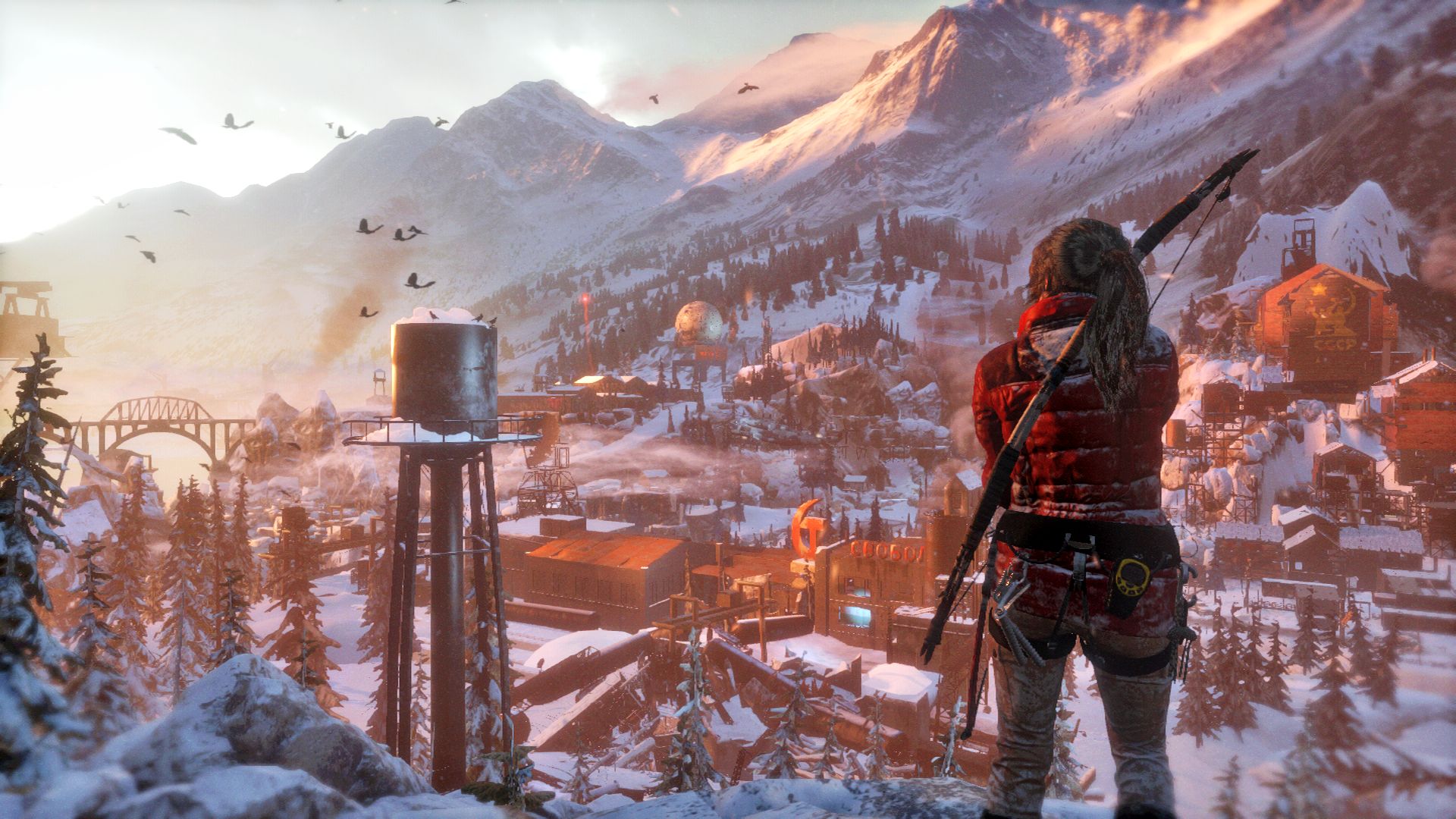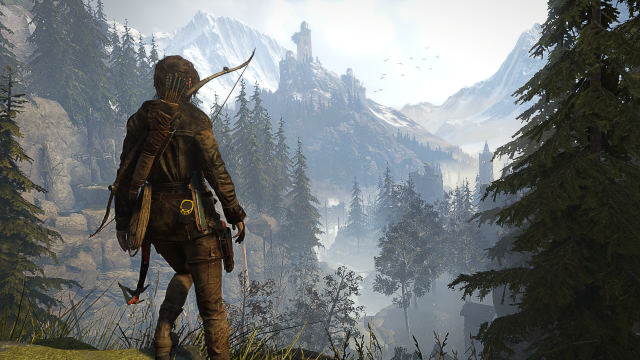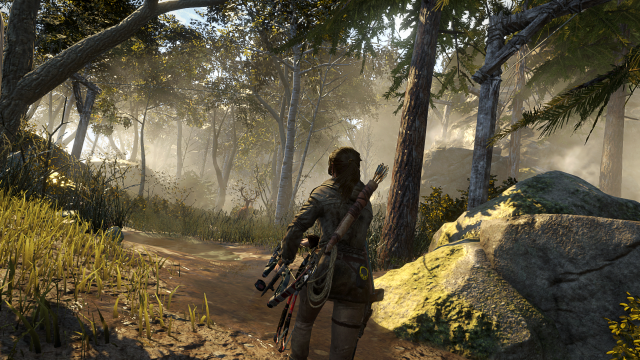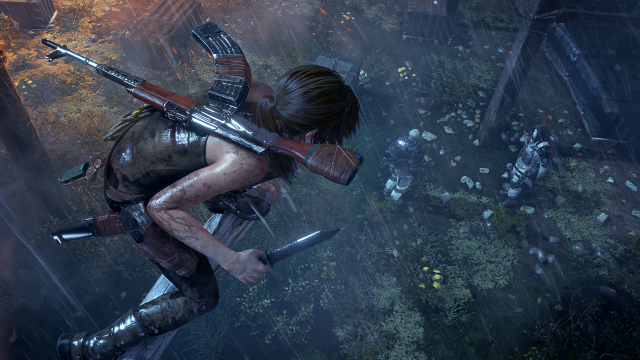Crystal Dynamics pulled off one of the most successful franchise reboots in recent memory with Tomb Raider back in 2013. Are they able to create a sequel worthy of the Tomb Raider franchise, or does this game tread too closely to its predecessor?
To be succinct, Rise of the Tomb Raider is one of the best games we’ve played this year. Here’s why.
Every component of Rise of the Tomb Raider looks real. The sum of its parts is unfortunately not a perfectly realistic world (from a visuals standpoint, that is) but each piece of the game is meticulously crafted to look and feel like it has been pulled from real life.
Leather looks like leather, fabrics have a real texture about them, and, perhaps most importantly, everything looks different (and once again, real) when wet or covered in snow or dirt, or once it has just become torn from repeated use.
Attention to detail has always been part of Crystal Dynamics’ prowess, and Rise of the Tomb Raider takes this beyond what we expect from video games. Few games are able to get human nature correct, and Tomb Raider is one of the few that excel at it. Lara routinely shivers in the cold, gripping her jacket and letting out frozen breaths as she hobbles along the deep snow of Siberia.
Lara’s feet create paths in the snow, and falling into it, or perhaps more satisfactorily, taking out an enemy in the snow by wrestling him to the ground, creates realistic imprints in the white stuff.
She pulls her hair back to wring it out as she exits the water, and her subtle limp from taking a hit is specific to the location of the wound. It’s very subdued and no attention is drawn to it, but these details are what makes us marvel over this game.
Every detail and component seems carefully considered and purposeful in the game. Each rock, bush, and stream looks and feel like it should in real life, with subtleties about each component somehow conveyed in the pixels on screen.
As much as the visuals are considered, the audio is equally as effective at creating a mood in Tomb Raider that is unparalleled.
Perhaps our favourite component of the audio production is hearing the whistling of the wind change based on Lara’s elevation along a mountainside. It isn’t just the difference between high on the mountain and higher, it has a clear progression as she navigates the rock face, and it only serves to improve the experience.
To those who do not think that audio design is important in a game, Rise of the Tomb Raider may be the best example of why it can be so crucial. Some incredibly tense moments are created almost exclusively from the audio design, especially in the village of the Deathless, where the darkness and ambient music does nothing but make Lara weary of what could be around any corner.
Rise of the Tomb Raider is clearly built on the original game’s levelling and crafting system, but that is a mere foundation for what the game has become.
A couple of different levelling systems now drive the experience, from the building of weapons, ammunition, as well as advancing Lara’s proficiency in different languages (Russian, Greek, and Mongolian), each of which function to further a different bit of the story. For example, reading murals and documents educates Lara in different languages, giving her the ability to understand monoliths and relics from earlier in the game, simultaneously lending to replayability.
Luckily, the crafting and levelling mechanic functions as part of the story. It rarely, if ever, feels like grinding for resources (until we began trying to get all the achievements well after we completed the title), but rather scavenging like someone who must conserve their energy and use every last bit of scrap they have to survive.
Levelling up also allows Lara to expand those weapon handling and crafting abilities. There are more than a dozen new materials ranging from wood to animal feathers, ore to poison mushrooms. Each item will help Lara craft a different kind of ammunition, our favourite of which is the poison arrow used to take down enemies as well as large animals with ease.
Those large animals are also a new facet of the game. They function as a sort of boss fight, and are something we’ve seen before. They’re not a common occurrence, but when they happen, they’re tense moments made even more so by the sheer size and roar of the guardian animal.
Building upon Lara’s skills are two enhancements to the original game: swimming and grappling. Both mechanics add something new to her adventure, though the grappling is exceptionally ridiculous most of the time. Seeing Lara’s climbing axe teetering precariously at the top of a rock cliff while Lara climbs her way up is completely unbelievable and is probably the only thing that removed us from the experience.
Luckily, swimming serves an actual function in the game, making it possible to stealthily kill enemies, as well as discover loot in otherwise hidden areas. It also functions as the solution to the solution of at least one tomb, but we’re not giving any details away on that one. Movement through the water is limited, but this serves as a teaser for what we expect to become a larger part of the third Tomb Raider (no, it hasn’t been announced, but we expect it by 2018). It’s a gameplay mechanic clearly in its infancy, but that’s likely the point: there’s so much to do here, swimming doesn’t need to take up half the game. Crystal Dynamics purposely used a sparing hand here, and it works as expected.
Survival instincts, on the other hand, were not so sparing. Clicking the right thumbstick (in the default control scheme), the entire screen becomes monochrome with the exception of key items and Lara’s next waypoint, all of which glow a golden sheen. It’s great to get you out of a bind or figure out where loot might be hiding, but it also negates some of the discovery within the game. You don’t have to use it, but it’s so easy to click that button; it may have been wise to add a limit to how often Lara can use it.
Side missions in 2013’s Tomb Raider took the form of lighting five lanterns in one area or burning six propaganda posters in another. In Lara’s Siberian outing, these quests are assigned to you by the tribe you align with early in the story. It opens up a believable reason for Lara to go accomplish these tasks. There’s also a reward system in place such that knocking out five radio towers (for example) gets Lara an upgrade to her gear that proves useful later on in the game. An appropriate amount of dialog between you and the tribe (known as the Remnants) also completes the loop; not to the volume of The Witcher or Fallout, but providing sufficient backstory for a game of its size.
In Tomb Raider games before the 2013 reboot, traps were a huge part of Lara’s world. They weren’t really present in Crystal Dynamics’ previous game unless you count the quick-moving run-for-your-life action sequences. We don’t. While traps have been re-added into the main experience of the game, they’re few and far between and don’t exist in perhaps the only place they should: in tombs.
Tombs are once again spaces that can be explored to discover the secrets of their Rube Goldberg machines within, and traps would be the perfect obstacle to further guard their treasure, but alas, they’re only featured in a few spots in the game, usually just while on the run from enemies.
Stealth has also become a facet of Lara’s adventure, though similar to the lack of traps, is grossly under-utilized and sometimes even broken. Lara has the ability to hide in bushes mere inches from enemies, but will only do this when the game decides that she should be crouched (usually in combat situations). Getting into any sort of combat will immediately pull Lara out of this cover, even if she would realistically be able to distract the guards away from her again to get back to safety. It is also entirely unrealistic to expect that no one would hear or see Lara climbing a tree five feet from an enemy troop’s position, degrading the experience of Tomb Raider slightly.
Traveling between areas in Tomb Raider has never been easier, though it is becoming increasingly less believable that everyone uses zippiness to get around in every game. They’re a lot of fun and make quick work of getting across a sprawling forest, but they don’t make for a very realistic experience in Siberia.
Forgetting that, however, is easy, as the design of every environment is stellar, and they all seem purpose-built with gameplay in mind. It always feels like something new is happening and Lara is finding her way into another cave or relic or monument with a different mechanic.
One of our favourite moments of the game was destroying two gates with a trebuchet which just happened to be stocked with asteroid-like flaming stones. Positioning the device wasn’t much fun, but pulling back on the right trigger launches a hurling ball of molten rock and the camera follows the projectile into its target in a way that is seldom seen in video games. It was riveting and just pure, giddy fun.
Tomb design is probably one of the biggest facets of Tomb Raider, and while there are only nine tombs (as spoiled by an achievement in the game’s hub), each of them is impeccably designed. Puzzles are not so much difficult as they are thought-provoking. Never are they frustrating if you allow each puzzle’s individual pieces to filter through the channels in your brain and produce a logical outcome. Trial and error is often the key, but it always yields something fruitful. This time around, rather than finding artifacts as a reward for completing a tomb, Lara is gifted with knowledge. For example, one tomb grants Lara the ability to craft a new type of fire which proves to be deadlier against her foes.
Without many side quests–we only actually did two while playing through the main story, opting to save them for the post-game experience–the main campaign of Rise of the Tomb Raider clocks in at roughly 14-15 hours, exactly where Crystal Dynamics said it would. While we expect to get a good chunk of gameplay out of it since completing the campaign, we don’t know if it will live up to its 30-40 hour estimate to 100% completion. We’d draw the full experience in at around 25 hours based on our percentage now and how much we’ve played of the game so far. Either way, a lengthy, meaty experience with lots to explore and even more to do.
Rise of the Tomb Raider does a great job highlighting the importance of backstory to a character, and Lara Croft has no shortage of interesting backstory.
This time, the focus is much more centralized around her father who was doubted by the international community of archaeologists and discoverers, something that Lara couldn’t quite come to grips with. Her father doesn’t play into the entire story but is one of the many threads woven throughout the narrative, and it works quite nicely to tie everything together.
Lara has a series of flashbacks throughout Rise, each of them serving to provide a bit of history to her character and the characters around her. Unfortunately, it only serves to make us aware of a very obvious plot twist which ends up being the story’s weakest point.
Luckily enough, moments after said twist, Lara lets out a solid “no FUCKING way,” in what is likely her best line of the two games Camilla Luddington has voiced. She also spits in someone’s face, adding to her badassery, of which she is lacking precisely none.
Lara is in search of the lost city of Kitezh, supposedly buried beneath the waters of central Russia. And of course, she isn’t the only one after its treasures. The evil organization also tasked with finding this city (which, of course, holds the key to immortality) is Trinity, a group that will seemingly stop at nothing to reach its goal.
It’s a concept we’ve heard before, but this is finally a story where the evil organization has a viable reason for managing to show up at the same place as Lara every time. Revealing this would be a pretty big spoiler, so let’s just say that it actually makes sense within the confines of the Tomb Raider universe presented before us.
Something that makes less sense however, is the amount of close calls Lara and her allies go through before being saved at the last second. We counted three times before the halfway mark of the game which, by the original title’s standards, is pretty low, but is still way off the mark for a game that touts realism and believability, at least, before you bring the supernatural elements of the story into the mix.
Missing is the tension of Lara’s first kill, only possible in the first game, but the story manages to retain its visceral, human foundation. Befriending the Remnants and exploring their village and the adjacent valley introduces new characters that are often forgettable, but many times provide valuable insight into the history of the sacred tribe.
The ending of the game is likely one of the more satisfying finalities of recent games. With titles like Halo 5: Guardians leaving us on a total cliffhanger, it is nice to see that Rise of the Tomb Raider can wrap things up coherently but still leave questions up for another title down the road.
Following the main story, Lara is shown with the Remnants with a new cutscene explaining that there is still work to do, further lending viability to why Lara is still exploring the Siberian wilderness. It isn’t perfect, but it does a great job of wrapping up the ending.
Human. Real. Believable. These are all words we’ve used countless times to describe Rise of the Tomb Raider. While it is not without its faults, it is an impeccably well-crafted game with superb production quality and a tightly-weaved narrative.
Perhaps the biggest compliment we could pay Rise of the Tomb Raider is that it is a game which left us still thinking about its world long after we stopped playing. Finishing a few hours of Rise of the Tomb Raider was mentally, even physically exhausting, and it left us fearful for Lara as we stepped away from the controller.
The best narrative experience we’ve had this year, Rise of the Tomb Raider mixes excellent gameplay with a fantastic soundtrack and beautiful visuals to become a serious contender for game of the year.






